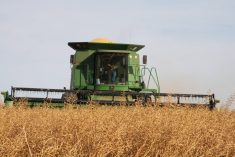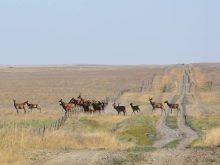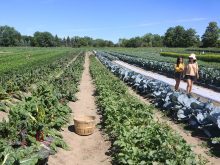After more than 30 years of seed farming, Jim Ternier did something different this year.
Thanks to a large order for Triticum turgdium, an ancient ancestor of modern-day durum, he planted his biggest ancient grain plot yet, a quarter-acre planted and harvested at St. Peter’s Abbey in Muenster on Sept. 23.
About 39 rows were planted, using slightly more than two pounds of seed and four hours of work with a push garden seeder.
Organic farmer Alberto Delogu in Wynyard, Sask., is looking to find modern uses for the grain.
Read Also

New program aims to support plant-based exports to Asia
Understanding the preferences of consumers in Taiwan and how they differ from Indonesia or Malaysia isn’t easy for a small company in Saskatchewan.
Ancient durum was primarily grown in the Mediterranean, he says, and used for pasta, bread, and couscous because it can be milled into semolina, a coarser, purified wheat.
While modern grains have slim heads of only a few up-reaching columns, Triticum turgium’s heads are heavy with branched seeds haphazardly stretching out along the head.
This made it difficult for large heads to be supported by the six-foot-tall stocks. After one strong wind, says Ternier, the stocks were hunched and bent, making it a challenge to harvest for the Wintersteiger five-foot header combine and combine operator Justin Gerspacher of the Prairie Agricultural Machinery Institute in Humboldt, Sask.
This year’s addition of the small combine by PAMI turned a job that would have taken Ternier days by hand into an hour-long harvest.
The harvest was a first for PAMI as well, says agrologist Katherine Gaetz. It normally does smaller plots of about five by 10 feet or five by 20 feet of conventional grains, so harvesting a large ancient grain plot was something it had never done.
Ternier plants, pollinates and harvests his usual plots, normally no bigger than his kitchen table, by hand, taking a quarter of his 400 seed collection and rotating planting to keep seed viable.
Grains, along with different varieties of vegetables and decorative plants, are then strategically planted at either St. Peter’s Abbey, Ternier’s garden in Humboldt or his family farm near Cochin, Sask., in the care of his daughter, Rachelle, who has taken over the majority of the family seed farm business, Prairie Garden Seed.
Ternier has worked at building his seed collection for more than 30 years, with the help of a wide-reaching grain collecting community.
He has received samples from government organizations, as well as private collectors, and is continuing to grow his collection and shares seeds within the community, including fellow collectors as far away as Australia.

















